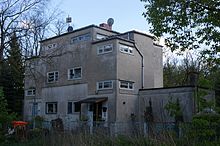Erwin Anton Gutkind
Erwin Anton Gutkind (born May 20, 1886 in Berlin ; † August 7, 1968 in Philadelphia , USA) was a German , then British architect , urban planner and architectural theorist until 1945 . As an architect, he designed convincing examples of classical modernism .
Life
Gutkind passed the Abitur in Berlin in 1904 . From 1905 to 1909 he studied architecture , urban planning , history , art history and sociology at the Technical University (Berlin-) Charlottenburg and the Humboldt University of Berlin under Heinrich Wölfflin, among others . In 1910 he married Margarete Jaffé, with whom he had two children. 1914 Goodchild was at the Technische Hochschule Charlottenburg for Doctor of Engineering (Dr.-Ing.) Graduated with work space and matter .
In April 1933 he emigrated to Paris, which resulted in the loss of all private property. A year later he returned to Berlin to help his relatives emigrate. In 1935 Gutkind moved to Hampstead (London) and relocated to Great Britain. For professional reasons he lived in Aberystwith in Wales from 1940 to 1942 .
In 1956 Gutkind married the sinologist Anneliese Bulling a second time. When he was appointed professor in the same year, Gutkind left London and moved to Philadelphia.
In 1968, the year of his death, Gutkind was awarded the Berlin Art Prize for Architecture. In 2003, a memorial plaque for Erwin Anton Gutkind was unveiled in the “Sonnenhof” residential complex in Berlin-Lichtenberg.
activity
Gutkind was a planning advisor for reconstruction in the Armistice Commission during the First World War . He then worked until 1923 in the Socialization Commission on the reorganization of housing with the status of a department head for settlement and urban planning in the Reich Ministry of Welfare. He then worked as a freelance architect and urban planner for ten years until he emigrated to Great Britain in 1933. His active work as an architect ended when he emigrated.
From 1935 to 1939 Gutkind advised the urban and state planning departments in London . During the Second World War he was initially director of the research project "Demographic Survey of the 1940 Council" until 1942 and in this position was responsible for town and country planning, particularly with immigration problems caused by the war. He then worked as a planning consultant for the British coal industry until the end of the war.
Gutkind was a member of the British Control Commission for Germany from 1945 to 1947 as a consultant for the reconstruction of the headquarters of the British Zone, which he then left in protest against their bureaucratic approach. After this time he was initially mainly active as a journalist. Much of his publications were printed in the Urbanistica and Architectural Design journals . Gutkind was appointed professor at the Graduate School of Fine Arts at the University of Pennsylvania in 1956 - at the age of 70 - where he wrote the eight-volume work International History of City Development . Erwin Anton Gutkind died in Philadelphia in 1968.
buildings
All of Gutkind's known buildings are in Berlin. In 1923 and 1924, the low-rise housing estate "New Jerusalem" , buildings in Heerstrasse and on Nennhauser Damm in Berlin-Staaken, were built here . In the following three years he was responsible for the construction of the residential complex “Am Eschengraben” for Hardanger Strasse 1–5, Thulestrasse 61 and Tahlstrasse 1–2a in Berlin. Between 1925 and 1927, the "Sonnenhof" residential complex between Marie-Curie-Allee, Delbrückstrasse, Archenholdstrasse and Bietzkestrasse in Berlin-Lichtenberg followed. This was followed by the grassland settlement in Berlin-Reinickendorf (1927), the pile block, also in Berlin-Reinickendorf in 1929, and the staging: "Sun, light and air for everyone" as an exhibition at the Berlin Exhibition Center in 1932.
Fonts
- Space and matter. An attempt to depict spatial development in terms of architectural history. Berlin 1915.
- New building . Basics of practical settlement activity , Verlag der Bauwelt, Berlin 1919.
- Residential buildings in Berlin in recent years. Berlin 1931. (with J. Schallenberger)
- Creative demobilization. London 1943.
- Revolution of environment. London 1946.
- Our world from the air. An international survey of man and his environment. London 1952.
- Community and environment. A discourse on social ecology. London 1953.
- The expanding environment. The end of cities, the rise of communities. London 1953.
- The twilight of cities. New York 1962.
- International History of City Development. (8 volumes) New York / London 1964–1968.
Web links
- Literature by and about Erwin Anton Gutkind in the catalog of the German National Library
- Works by and about Erwin Anton Gutkind in the German Digital Library
- Erwin Anton Gutkind. In: arch INFORM .
- Erwin Gutkind collection in the archive of the Academy of Arts, Berlin
Individual evidence
- ↑ Rudolf Hierl: Erwin Gutkind 1886-1968. Architecture as urban space art. Birkhäuser, Basel / Boston / Berlin 1992, ISBN 3-76432689-1 , p. 14.
| personal data | |
|---|---|
| SURNAME | Gutkind, Erwin Anton |
| BRIEF DESCRIPTION | German and British architect, urban planner and architectural theorist |
| DATE OF BIRTH | May 20, 1886 |
| PLACE OF BIRTH | Berlin |
| DATE OF DEATH | 7th August 1968 |
| Place of death | Philadelphia |

